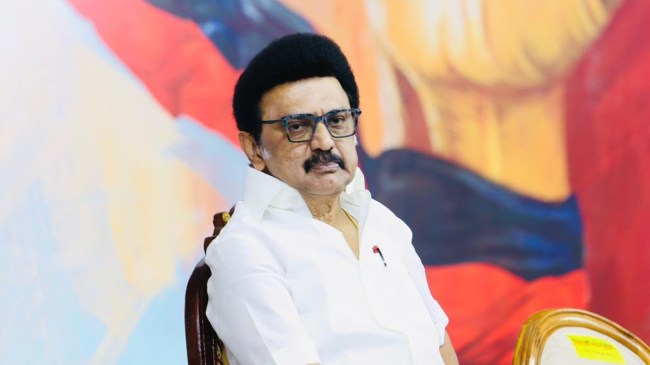Keezhadi row: Expert transferred again, CM Stalin says: ‘How many hurdles before Tamil race?’
Archaeologist K Amarnath Ramakrishna transferred for third time in nine months, days after he declined to revise his ‘final’ report dating Sangam settlement further back than previously thought
 Chief Minister M K Stalin said people should gather in large numbers for the protest organised by the DMK youth wing against the Centre’s move to “sabotage” the Keezhadi excavations and findings. (Source: FB)
Chief Minister M K Stalin said people should gather in large numbers for the protest organised by the DMK youth wing against the Centre’s move to “sabotage” the Keezhadi excavations and findings. (Source: FB) K Amarnath Ramakrishna, the archaeologist known for his excavation work at Keezhadi, has been transferred from his post of Director of Antiquity at the National Mission on Monuments and Antiquities (NMMA) to Director of the NMMA’s Greater Noida office.
 The transfer comes less than a month after Ramakrishna declined to revise his 982-page ‘final’ report on Keezhadi, submitted to the ASI in January 2023. It is Ramakrishna’s third transfer in nine months.
The transfer comes less than a month after Ramakrishna declined to revise his 982-page ‘final’ report on Keezhadi, submitted to the ASI in January 2023. It is Ramakrishna’s third transfer in nine months.Hitting out at the Centre over the transfer, Chief Minister M K Stalin said people should gather in large numbers for the protest organised by the DMK youth wing against the Centre’s move to “sabotage” the Keezhadi excavations and findings.
In a statement Tuesday, he said: “How many hurdles have been placed before our Tamil race? And yet, for thousands and thousands of years, we have resisted them, fought back, and established the antiquity of our people with the support of science! Still, there are some minds that refuse to accept it. It is not the reports that need correction – it is those minds!”
Su Venkatesan, the CPI(M) MP from Madurai, said: “Amarnath Ramakrishna is being relentlessly hunted down for the truth he uncovered… The people of Tamil Nadu will give an appropriate response to the deceitful actions of the Union government.” The CPI(M) is an ally of the DMK government in Tamil Nadu.
The Stalin government, which has made ‘Dravidian’ pride the centrepiece of its politics, considers the Keezhadi findings a key part of this – as they date the settlement to around the same time as the Indus Valley Civilization.
Stalin and his ministers had reacted sharply to the letter written by ASI Director (Exploration & Excavation) Hemasagar A Naik on May 21 asking Ramakrishna to revise his findings, citing feedback from two unnamed experts.
Stalin accused the BJP of “selectively” accepting historical narratives. “Even when confronted with carbon-dated artefacts and AMS (Accelerator Mass Spectrometry) reports from international laboratories on the Keezhadi excavations, they continue to demand ‘more proof’,” he said. “They do so without credible evidence, while dismissing the rigorously proven antiquity of Tamil culture… We fought for centuries to unearth our history. They fight every day to erase it.”
Tamil Nadu Finance and Archaeology Minister Thangam Thennarasu said: “First, they said there was nothing in Keezhadi. Then the archaeologist was transferred. Later, they refused to allocate funds. Finally, they shelved the report for two years. Now they demand more proof.”
During a recent visit to Chennai, Union Culture Minister Gajendra Singh Shekhawat backed the questions raised over Ramakrishna’s report, saying “it was not technically well-supported and established yet”. “Let them come up with more results, more data, evidence, and proof. One finding cannot change the discourse of history.”
He added: “People in positions are trying to flare up regional sentiments, but we need to be cautious. This is a subject not to be decided by politicians but by archaeologists with sound technical expertise.”
Ramakrishna has stood by his findings, citing “documentary evidence” and scientific dating methods such as AMS to show that the Sangam-era urban settlement in Keezhadi goes back to 585 BCE. This puts it contemporaneous to Indus Valley, and potentially contradicts the Sangh’s theory of who the original settlers of the Indian region were.
The letter by ASI Director Naik, asking Ramakrishna to revise the report, said the dating of the earliest cultural phase – between the 8th and 5th centuries BCE – required “concrete justification”, and suggested that “in the present state of our knowledge”, it could be no earlier than 300 BCE.
In a written reply two days later, Ramakrishna said: “The period of the site was reconstructed as per the stratigraphical sequence, cultural deposit available with material culture and with the AMS date found during the excavation… The outcome of the observation of the excavator was incorporated in the final report with all documentary evidence.”
Ramakrishna added that relevant nomenclature changes had already been accepted and communicated in 2023. “The view expressed by you for further examination of sequence is against the well-reasoned conclusive finding of the excavator of the site,” he wrote to Naik.
Earlier, in 2017, Ramakrishna had been transferred to Assam just months after his preliminary findings from Keezhadi became known. His successor at the site dismissed the third phase of excavations as yielding “no significant findings”. The Madurai Bench of the Madras High Court eventually allowed the Tamil Nadu State Department of Archaeology to take over the dig, which is now entering its 11th phase, with over 20,000 artefacts unearthed.
In September 2024, Ramakrishna was transferred after promotion to Director (Excavation & Exploration), only to be moved to Director (Antiquity) three months later.






